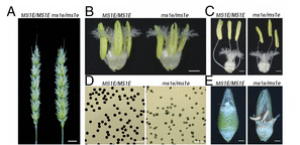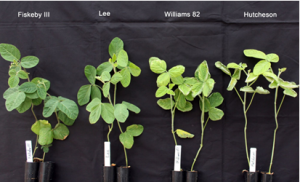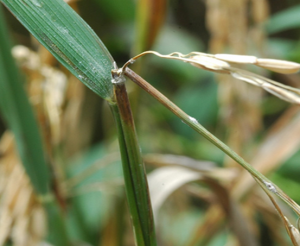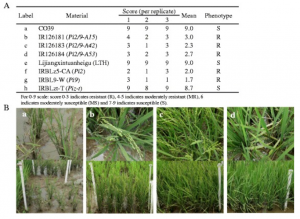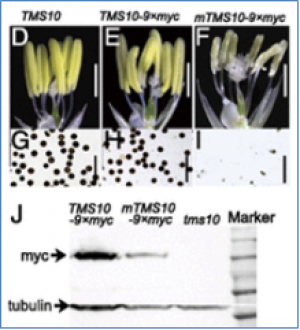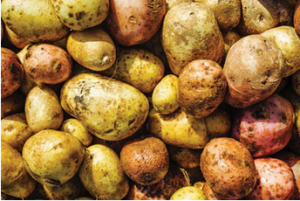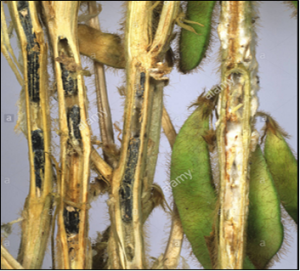microRNAs (miRNAs) are important regulators in plant growth and development. miR159 is a conserved miRNA among different plant species and has various functions in plants. Studies on miR159 are mostly done on model plant, Arabidopsis thaliana. In rice, studies on miR159 were either based upon genome-wide expression analyses focused upon responses to different nitrogen forms and abiotic stress or upon phenotypic studies of transgenic plants overexpressing its precursor.
Heterosis provides an important strategy for increasing crop yield, and breeding and adoption of hybrid crops is a feasible way to increase crop yields. Male sterility is an essential trait in hybrid seed production for monoclinous crops, including wheat. Heterosis in wheat was observed approximately 100 y ago. However, very little commercial hybrid wheat is planted in the world because of the lack of a suitable male sterility trait.
Breeding soybean for tolerance to high salt conditions is important in some regions of the USA and world. Soybean cultivar Fiskeby III (PI 438471) in maturity group 000 has been reported to be highly tolerant to multiple abiotic stress condi-tions, including salinity. In this study, a mapping population of 132 F2 families derived from a cross of cultivar Williams 82 (PI 518671, moderately salt sensitive) and Fiskeby III (salt tolerant) was analyzed to map salt tolerance genes.
Rice blast is the most serious disease afflicting rice and there is an urgent need for the use of disease resistance (R) genes in blast tolerance breeding programs. Pb1 is classified as a quantitative resistance gene and it does not have fungal specificity. Pb1-mediated resistance develops in the latter stages of growth. However, some cultivars, such as Kanto209 (K209), cultivar name Satojiman, despite possessing Pb1, do not exert resistance to rice blast during the reproductive stage.
The rice Pi2/9 locus harbors multiple resistance (R) genes each controlling broad-spectrum resistance against diverse isolates of Magnaporthe oryzae, a fungal pathogen causing devastating blast disease to rice. Identification of more resistance germplasm containing novel R genes at or tightly linked to the Pi2/9 locus would promote breeding of resistance rice cultivars.
Maize is a diverse paleotetraploid species with considerable presence/absence variation and copy number variation. One mechanism through which presence/absence variation can arise is differential fractionation. Fractionation refers to the loss of duplicate gene pairs from one of the maize subgenomes during diploidization. Differential fractionation refers to non-shared gene loss events between individuals following a whole genome duplication event.
Mitogen-activated protein kinase kinase kinases (MAPKKKs), an important unit of MAPK cascade, play crucial roles in plant development and response to various stresses. However, little is known concerning the MAPKKK family in the important subtropical and tropical crop cassava. In this study, 62 MAPKKK genes were identified in the cassava genome, and were classified into 3 subfamilies based on phylogenetic analysis. Most of MAPKKKs in the same subfamily shared similar gene structures and conserved motifs. The comprehensive transcriptome analysis showed that MAPKKK genes participated in tissue development and response to drought stress.
By affecting male fertility in crops, climate temperature change has a major impact on global food security. Here we show the role of two rice leucine-rich repeat–receptor-like kinases, TMS10 and TMS10L, which redundantly control male fertility under fluctuating temperatures. This finding provides insights into how plants overcome adversary temperature changes to achieve normal male fertility and a new genetic resource for crop hybrid seed production.
Worldwide, potato is the third most important crop grown for direct human consumption, but breeders have struggled to produce new varieties that outperform those released over a century ago, as evidenced by the most widely grown North American cultivar (Russet Burbank) released in 1876. Despite its importance, potato genetic diversity at the whole-genome level remains largely unexplored.
Sclerotinia Stem Rot (SSR), caused by the fungal pathogen Sclerotinia sclerotiorum, is ubiquitous in cooler climates where soybean crops are grown. Breeding for resistance to SSR remains challenging in crops like soybean, where no single gene provides strong resistance, but instead, multiple genes work together to provide partial resistance. In this study, a genome-wide association study (GWAS) was performed to dissect the complex genetic architecture of soybean quantitative resistance to SSR and to provide effective molecular markers that could be used in breeding programs.


 Curently online :
Curently online :
 Total visitors :
Total visitors :

